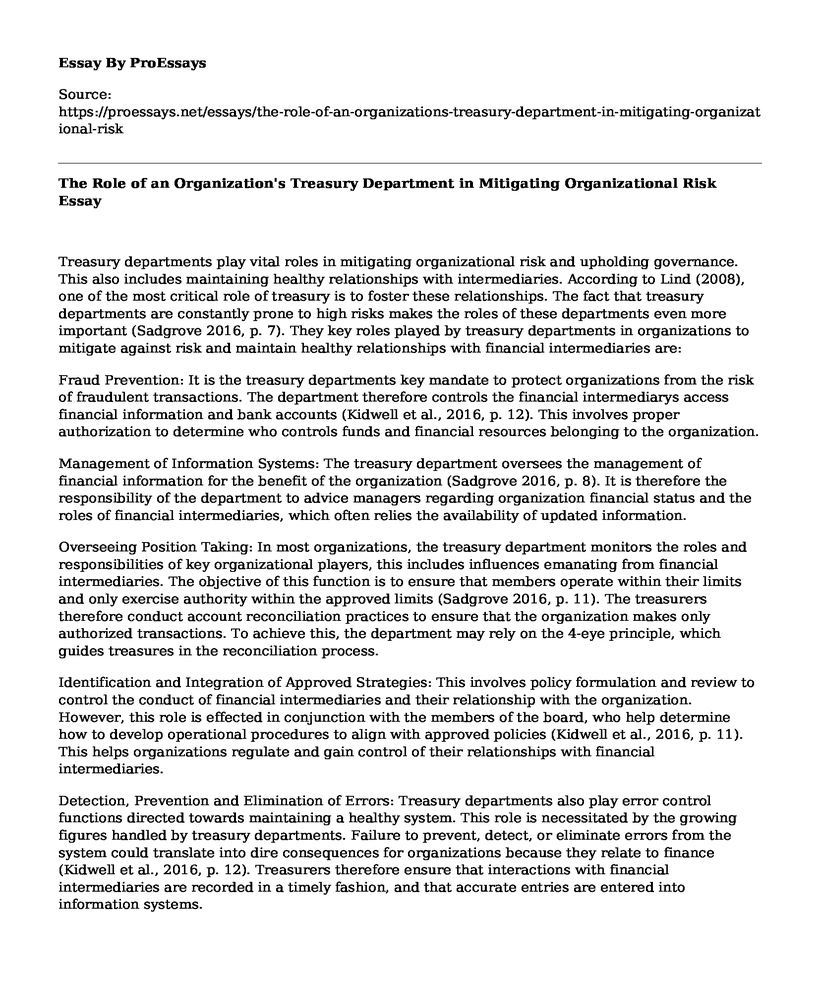Treasury departments play vital roles in mitigating organizational risk and upholding governance. This also includes maintaining healthy relationships with intermediaries. According to Lind (2008), one of the most critical role of treasury is to foster these relationships. The fact that treasury departments are constantly prone to high risks makes the roles of these departments even more important (Sadgrove 2016, p. 7). They key roles played by treasury departments in organizations to mitigate against risk and maintain healthy relationships with financial intermediaries are:
Fraud Prevention: It is the treasury departments key mandate to protect organizations from the risk of fraudulent transactions. The department therefore controls the financial intermediarys access financial information and bank accounts (Kidwell et al., 2016, p. 12). This involves proper authorization to determine who controls funds and financial resources belonging to the organization.
Management of Information Systems: The treasury department oversees the management of financial information for the benefit of the organization (Sadgrove 2016, p. 8). It is therefore the responsibility of the department to advice managers regarding organization financial status and the roles of financial intermediaries, which often relies the availability of updated information.
Overseeing Position Taking: In most organizations, the treasury department monitors the roles and responsibilities of key organizational players, this includes influences emanating from financial intermediaries. The objective of this function is to ensure that members operate within their limits and only exercise authority within the approved limits (Sadgrove 2016, p. 11). The treasurers therefore conduct account reconciliation practices to ensure that the organization makes only authorized transactions. To achieve this, the department may rely on the 4-eye principle, which guides treasures in the reconciliation process.
Identification and Integration of Approved Strategies: This involves policy formulation and review to control the conduct of financial intermediaries and their relationship with the organization. However, this role is effected in conjunction with the members of the board, who help determine how to develop operational procedures to align with approved policies (Kidwell et al., 2016, p. 11). This helps organizations regulate and gain control of their relationships with financial intermediaries.
Detection, Prevention and Elimination of Errors: Treasury departments also play error control functions directed towards maintaining a healthy system. This role is necessitated by the growing figures handled by treasury departments. Failure to prevent, detect, or eliminate errors from the system could translate into dire consequences for organizations because they relate to finance (Kidwell et al., 2016, p. 12). Treasurers therefore ensure that interactions with financial intermediaries are recorded in a timely fashion, and that accurate entries are entered into information systems.
Conducting a Treasury Audit: The treasury department is tasked with conducting financial audits and reviewing the organizations financial records. The purpose of this is to ensure that the organization accounts for the internal and external financial transactions and records them for reference and future decision-making purposes. To achieve this, the treasury departments maintain correspondence with financial intermediaries and stakeholders in the organization (Kidwell et al., 2016, p. 15). The departments is also responsible for ensuring that the most recent and responsive approaches are adopted for financial audit. In this case, the department remains open to emergent technologies and management practices in the business environment.
References
Kidwell, D.S., Blackwell, D.W., Whidbee, D.A. and Sias, R.W., 2016.Financial institutions, markets, and money. John Wiley & Sons.Kohn, M. 2004. Financial institutions and markets. 2nd ed. New York: Oxford University Press.
Lind, M., 2008. Bank relationship strategy and management. Journal of Corporate Treasury Management, 1(3).Sadgrove, K., 2016. The complete guide to business risk management. Routledge.
Cite this page
The Role of an Organization's Treasury Department in Mitigating Organizational Risk. (2021, Jun 28). Retrieved from https://proessays.net/essays/the-role-of-an-organizations-treasury-department-in-mitigating-organizational-risk
If you are the original author of this essay and no longer wish to have it published on the ProEssays website, please click below to request its removal:
- Nurse Leadership and Management in Patient Satisfaction: A Comparative Approach
- How Management Concepts Have Impacted Ethiopian Airlines Strategic Discourses
- BHF Restaurant Business Plan
- Key Issues, Problems and Opportunities of Jimmy Badger Case of Leadership
- Essay on NJ Motor Vehicles Commission: Breach of Employee Contract
- Essay on My Journey to Leadership: A Story of Success
- Essay Example on Data Breach at Trexpendition: Risks and Solutions







